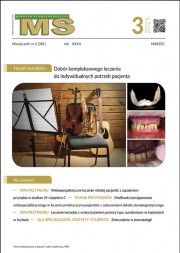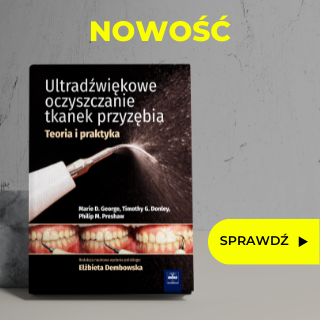Dostęp do tego artykułu jest płatny.
Zapraszamy do zakupu!
Po dokonaniu zakupu artykuł w postaci pliku PDF prześlemy bezpośrednio pod twój adres e-mail.
STUDIA PRZYPADKÓW
Zastosowanie infiltracji w leczeniu MIH zębów przednich – opisy przypadków
Anna Jarząbek, Aleksandra Wdowiak-Szymanik, Agnieszka Kus-Bartoszek
PIŚMIENNICTWO
- Lygidakis NA, Garot E, Somani C i wsp. Best clinical practice guidance for clinicians dealing with children presenting with molar-incisor-hypomineralisation (MIH): An updated European Academy of Paediatric Dentistry policy document. Eur Arch Paediatr Dent. 2022; 23(1): 3-21.
- Denis M, Atlan A, Vennat E i wsp. White defects on enamel. Diagnosis and anatomopathology: two essential factors for proper treatment (part 1). Int Orthod. 2013; 11(2): 139-165.
- Icon smooth surface. Case reports. On-line: https://pl.dmg-dental.com/fileadmin/user_upload/Germany/products/Icon_vestibular/Casebook_IconVE_07022019_en.pdf [dostęp: 21.08.2024].
- Somani C, Taylor GD, Garot E i wsp. An update of treatment modalities in children and adolescents with teeth affected by molar incisor hypomineralisation (MIH). A systematic review. Eur Arch Paediatr Dent. 2022; 23(1): 39-64.
- Petrou MA, Giraki M, Bissar AR i wsp. Prevalence of molar-incisor hypomineralisation among school children in four German cities. Int J Paediatr Dent. 2014; 24(6): 434-440.
- William V, Messer LB, Burrow MF. Molar incisor hypomineralization. Review and recommendations for clinical management. Pediatr Dent. 2006; 28(3): 224-232.
- Ghanim A, Manton D, Mariño R i wsp. Prevalence of demarcated hypomineralisation defects in second primary molars in Iraqi children. Int J Paediatr Dent. 2013; 23(1): 48-55.
- Krishnan R, Ramesh M. Molar incisor hypomineralisation. A review of its current concepts and management. SRM J Res Dent Sci. 2014; 5(4): 248-252.
- Garg N, Jain AK, Saha S i wsp. Essentiality of early diagnosis of molar incisor hypomineralization in children and review of its clinical presentation, etiology and management. Int J Clin Pediatr Dent. 2012; 5(3): 190-196.
- Hasmun N, Vettore MV, Lawson JA i wsp. Determinants of children’s oral health-related quality of life following aesthetic treatment of enamel opacities. J Dent. 2020; 98: 103372.
- Ozgur B, Unverdi GE, Ertan AA i wsp. Effectiveness and color stability of resin infiltration on demineralized and hypomineralized (MIH) enamel in children. Six-month results of a prospective trial. Oper Dent. 2023; 48(3): 258-267.
- Nogueira VKC, Mendes Soares IP, Fragelli CMB i wsp. Structural integrity of MIH-affected teeth after treatment with fluoride varnish or resin infiltration. An 18-month randomized clinical trial. J Dent. 2021; 105: 103570.
- Attal JP, Atlan A, Denis M i wsp. White spots on enamel. Treatment protocol by superficial or deep infiltration (part 2). Int Orthod. 2014; 12(1): 1-31.
- Kotsanos N, Kaklamanos EG, Arapostathis K. Treatment management of first permanent molars in children with molar-incisor hypomineralisation. Eur J Paediatr Dent. 2005; 6(4): 179-184.
- Jälevik B, Klingberg GA. Dental treatment, dental fear and behaviour management problems in children with severe enamel hypomineralization of their permanent first molars. Int J Paediatr Dent. 2002; 12(1): 24-32.
- Da Costa-Silva CM, Ambrosano GM, Jeremias F i wsp. Increase in severity of molar-incisor hypomineralization and its relationship with the colour of enamel opacity. A prospective cohort study. Int J Paediatr Dent. 2011; 21(5): 333-341.
- Dyrektywa Rady 2011/84/UE z dnia 20 września 2011 r. zmieniająca dyrektywę 76/768/EWG dotyczącą produktów kosmetycznych w celu dostosowania jej załącznika III do postępu technicznego, Dziennik Urzędowy Unii Europejskiej, 29.10.2011, L 283/36.















